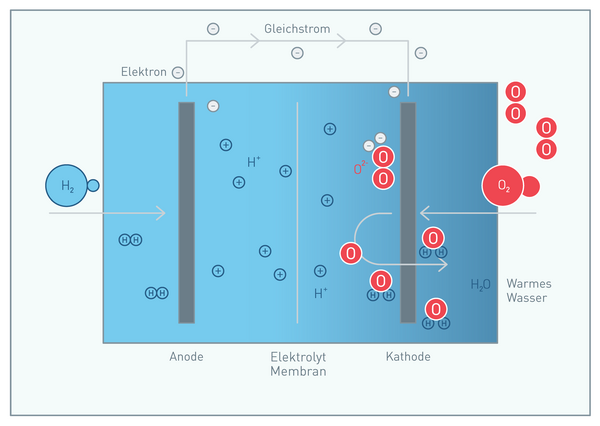Fuel cell: key technology for the energy transition and sustainable mobility
The importance of hydrogen fuel cells is growing steadily in the course of the energy transition. Hydrogen is considered a promising energy source that can contribute to the decarbonization of various sectors such as mobility, industry and energy. Fuel cells play a central role here, as they can efficiently convert hydrogen into electrical energy. In this blog post, we shed light on how fuel cells work, their potential applications and the challenges and opportunities associated with using hydrogen as an energy source.
What is a fuel cell?
A fuel cell is an electrochemical cell that converts the chemical energy of a fuel (in this case hydrogen) directly into electrical energy without the detour of combustion. The process in the fuel cell is highly efficient and results in emission-free energy generation, as the only by-product is water.
Structure and function of the fuel cell
The fuel cell essentially consists of three main components:
1. Anode (negative electrode): This is where hydrogen is split into protons and electrons. The hydrogen reacts at the anode, whereby the electrons are discharged via an external circuit and can be used as electricity. The reaction equation is: H2→2H++2e-H₂ → 2H⁺ + 2e-H2 →2H++2e-
2. Cathode (positive electrode): At the cathode, the supplied oxygen reacts with the protons (H⁺), which migrate through a proton exchange membrane (PEM) to the cathode, and the electrons, which flow through the external circuit. The result is the formation of water: O2+4H++4e-→2H2OO₂ + 4H⁺ + 4e- → 2H₂OO2 +4H++4e-→2H2 O
3. Electrolyte: The electrolyte in a fuel cell, often a proton exchange membrane, ensures that only protons (H⁺) pass from the anode to the cathode, while the electrons flow via the external circuit to generate an electric current.
Application areas of hydrogen and fuel cells
Hydrogen and fuel cells offer a wide range of potential applications in various areas of the economy and everyday life. The following sectors are particularly noteworthy:
1. Mobility
Fuel cell electric vehicles (FCEVs) are a promising alternative to battery electric vehicles (BEVs), especially for heavy-duty transportation, buses, trains and even ships. These vehicles generate the required electrical energy by reacting hydrogen with oxygen in a fuel cell, producing only water as a waste product. A major advantage of fuel cell vehicles is the short refueling time of a few minutes and the long range, which makes them particularly attractive for long-distance applications.
2. Energy storage
Hydrogen can be used as a storage medium for surplus electricity from renewable energy sources. When wind and solar power plants produce more energy than is consumed, the electricity can be used to electrolyze water to produce hydrogen. This hydrogen can later be converted back into fuel cells to supply electricity when needed. In this way, hydrogen helps to stabilize the power grid and enables the long-term storage of renewable energy.
3. Industry
Hydrogen is already used on a large scale in industry, e.g. in the chemical industry for ammonia production or in the refinery industry. Switching to green hydrogen in these sectors could reduce significant amounts of CO₂ emissions. Hydrogen is also gaining importance in the steel industry, as it can be used as a substitute for coal in blast furnace technology to minimize carbon emissions.
Fuel cell: Research and development services at AIT
The AIT Austrian Institute of Technologie makes a significant contribution to the advancement of hydrogen and fuel cell technologies. With a wide range of research and development services, the AIT supports the industry in implementing innovative solutions. The core areas include:
- Development and validation of materials, components and systems
The AIT offers comprehensive expertise in the development and validation of new materials that are particularly suitable for use in hydrogen technologies and fuel cells. Innovative components and systems are tested and optimized under realistic conditions. - Development of electrode materials
The development of high-performance electrode materials is a central focus. The aim is to increase the efficiency and service life of fuel cells and at the same time reduce material costs. - Development of new technology concepts
In addition to the further development of existing technologies, the AIT is working on completely new concepts to make the use of hydrogen as an energy source more economical and sustainable. State-of-the-art simulation and modeling methods as well as highly developed testing technologies are being used.
Research and development: the path to mass application
Scientists and companies around the world are working to further develop hydrogen fuel cell technology and make it more economical. The most important fields of research include
- Cost reduction: the further development of catalysts and materials for fuel cells and the scaling of production are intended to reduce the costs of fuel cell vehicles and hydrogen infrastructures.
- Increasing efficiency: New designs and materials can help to further increase the efficiency of fuel cells. The improvement of electrolysis processes for hydrogen production is also a key issue.
- Storage technologies: Advances in hydrogen storage are necessary to increase energy density and ensure safe handling. New materials and pressure storage systems play an important role here.
Future prospects for hydrogen and fuel cells
Hydrogen and fuel cells are regarded as key components of the energy transition. In the coming years, the technology is expected to play an increasingly important role in mobility, industry and energy supply. Fuel cells will find their place in heavy goods transport in particular and in areas where battery-powered solutions are not practical.
There are also promising potential applications in the context of Power-to-X technologies, in which hydrogen is used to produce synthetic fuels or as a storage medium. With the right political framework, investment in research and development and the expansion of the hydrogen infrastructure, hydrogen fuel cell technology will become established in many sectors.




